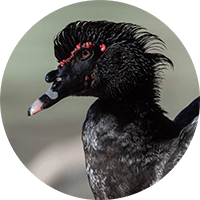Muscovy Duck
Appearance: The Muscovy Duck weighs from 2.5 to 3.7 kg and measures 86 cm. They have a black plumage with large white patches on wings. Eyes are yellowish-brown. Male with short crest on the nape. Bill is black with some tones of pink, and its base shows a dark red knob. The bare skin of its face is red. Black legs and webbed feet with long claws. Tail is wide and flat. They exudate a musk smell. Sexual dimorphism evident in the plumage of the smaller female with dark brown or black feathers mixed with white on the head, as well as, lavender or all white. Both sexes have a nude black-and-red or all-red face. Some may have blue eyes in a dark head.
Habitat: These ducks inhabit forested swamps and lakes near grasslands and roost in trees for nocturnal resting at elevations lower than 1000 m. They only quack in cases of extreme stress. They feed on plant material, small fish, and insects. Due to their weight they are consumed in restaurants.
Breeding: Males present a helical penis that erects to 20 cm (7.9 in) in 1/3 second. Whereas females present cloacas in the opposite direction that seems to have been evolved to limit forced copulation by males. The clutch consists of 8 to 16 white eggs that are incubated for 35 days.
Conservation: The Muscovy Ducks are classified as a species of "Least Concern" on the International Union for Conservation of Nature (IUCN) Red List.
Distribution
Amazon Region: The Muscovy duck is commonly found in the damp lowlands of the Amazon rainforest, taking advantage of the wetlands and rivers that provide a suitable habitat.
Andean Region: In the Andean mountains, the duck can be found in areas with accessible water bodies such as lakes, rivers, and lagoons at various altitudes, particularly in the eastern and western slopes.
Caribbean Region: Coastal areas and wetlands provide a habitat for the Muscovy duck along the Caribbean coast. It thrives in swampy regions and areas with abundant aquatic vegetation.
Pacific Region: Similar to the Caribbean, the Pacific lowlands offer suitable environments for the Muscovy duck, where it can inhabit mangroves and estuarine wetlands.
Orinoquía Region: In the plains of the Orinoquía region, Muscovy ducks can be found in lagoons and rivers, benefiting from the extensive wetlands.
Taxonomy
- Kingdom: Animalia
- Phylum: Chordata
- Class: Aves
- Order: Anseriformes
- Family: Anatidae
- Subfamily: Anatinae
- Genus: Cairina
- Species: Cairina moschata
Vocalization
Hissing: Males, in particular, are known for their distinctive hissing sounds, which they make by expelling air forcefully with their beaks. This hissing sound is often used as a territorial display or as a means of communication during courtship.
Whistling: Muscovy ducks can emit a series of short whistling sounds, especially during moments of distress or agitation. This can include high-pitched whistles or quieter whistling sounds.
Grunting: Muscovy ducks produce deep and throaty grunts, especially during interactions with other birds. These grunting sounds can be heard during aggressive encounters, mating rituals, or general social interactions.
Chattering: Muscovy ducks can engage in chattering sounds, which can be described as a rapid series of vocalizations. This is often heard when ducks are in close proximity to one another and may serve as a form of general communication or social bonding.













